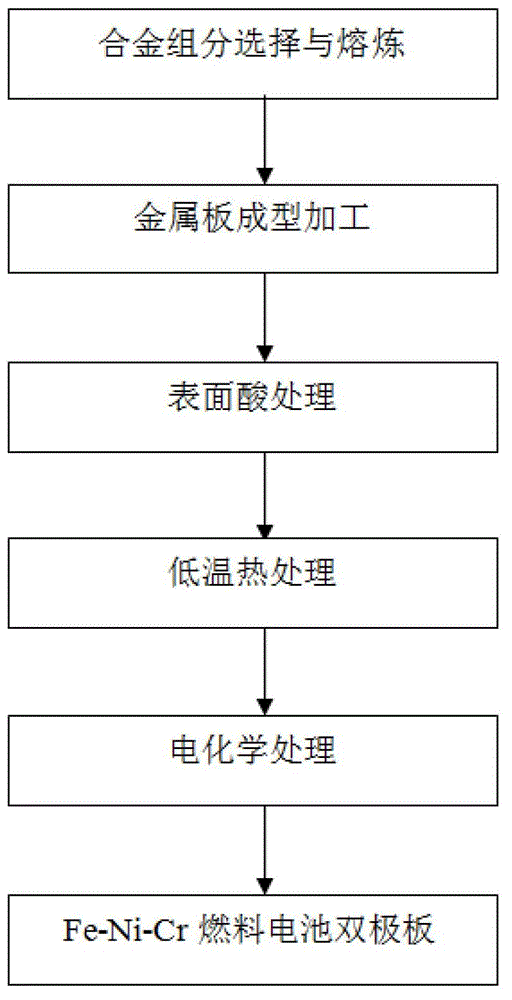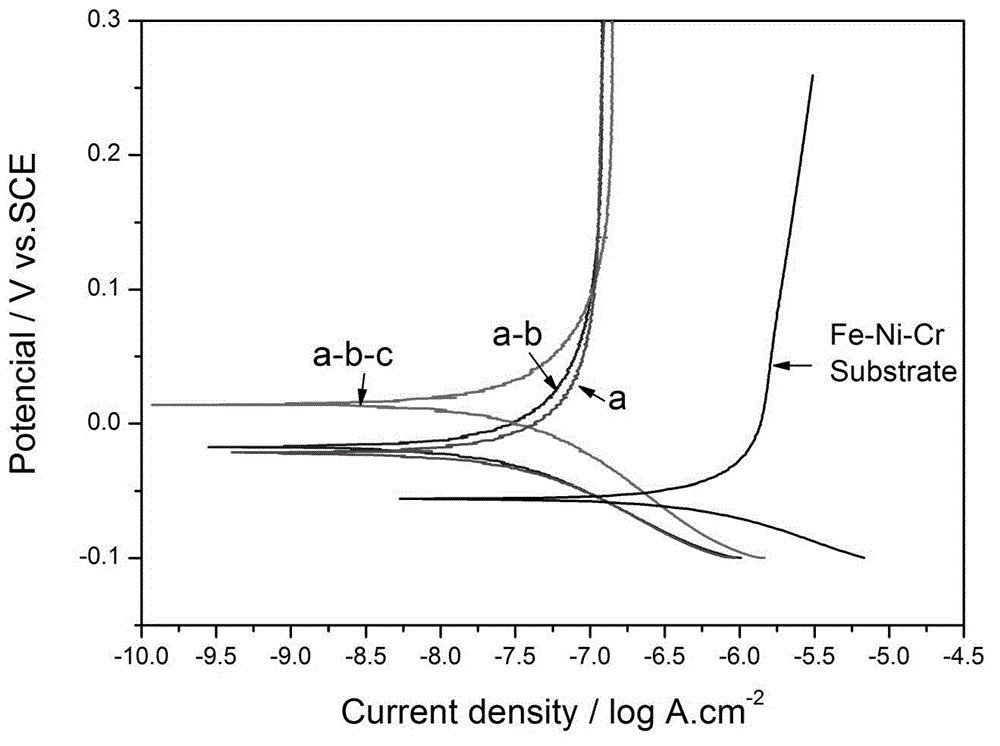In-situ preparation method of carbonized film on surface of Fe-Ni-Cr bipolar plate
1. fe-ni-cr, surface carbonization technology, applied in the direction of battery electrodes, electrical components, circuits, etc. To avoid problems such as falling off, to achieve the effects of not being easily deformed, improving electrical conductivity and corrosion resistance, and having good corrosion resistance
- Summary
- Abstract
- Description
- Claims
- Application Information
AI Technical Summary
Problems solved by technology
Method used
Image
Examples
Embodiment 1
[0031] Such as figure 1 Shown, the in-situ preparation method of the carbide film on the surface of Fe-Ni-Cr bipolar plate, it comprises the following steps:
[0032] (1) Selection and smelting of alloy components: According to the composition of 38% Fe (atomic percentage), 33% Ni (atomic percentage), and 29% Cr (atomic percentage), Fe is obtained by vacuum induction melting 38 Ni 33 Cr 29 Alloy (vacuum induction melting is a conventional method);
[0033] (2) Metal plate forming processing: process the above alloy into a metal plate with a flow field according to conventional methods;
[0034] (3) Surface chemical treatment: Place the metal plate with flow field in HF aqueous solution with a volume concentration of 47%, soak it at 25°C for 8 minutes, take it out, wash it with water, and dry it. Then put it into a vacuum furnace, pass argon, heat treatment at 250 ° C for 2 hours, and then cool with the furnace; then put in H 2 SO 4 and HF mixed aqueous solution, H 2 SO ...
Embodiment 2
[0044] Such as figure 1 Shown, the in-situ preparation method of the carbide film on the surface of Fe-Ni-Cr bipolar plate, it comprises the following steps:
[0045] (1) Selection and smelting of alloy components: According to the composition of 37% Fe (atomic percentage), 34% Ni (atomic percentage), and 29% Cr (atomic percentage), Fe is obtained by vacuum induction melting 37 Ni 34 Cr 29 Alloy (vacuum induction melting is a conventional method);
[0046] (2) Metal plate forming processing: process the above alloy into a metal plate with a flow field according to conventional methods;
[0047] (3) In-situ treatment of the surface: place the metal plate with a flow field in an HF aqueous solution with a volume concentration of 45%, treat it at 30°C for 9 minutes, take it out, wash it with water, and dry it; then put it into a vacuum furnace, pass argon, Heat treatment at 300°C for 1 hour; then put in H 2 SO 4 and HF mixed aqueous solution, H 2 SO 4 The concentration of...
Embodiment 3
[0050] Such as figure 1 Shown, the in-situ preparation method of the carbide film on the surface of Fe-Ni-Cr bipolar plate, it comprises the following steps:
[0051] (1) Selection and smelting of alloy components: according to the composition of 39% Fe (atomic percentage), 33% Ni (atomic percentage), and 28% Cr (atomic percentage), Fe is obtained by vacuum induction melting 39 Ni 33 Cr 28 Alloy (vacuum induction melting is a conventional method);
[0052] (2) Metal plate forming processing: process the above alloy into a metal plate with a flow field according to conventional methods;
[0053] (3) Surface in-situ treatment: place the metal plate in a 50% HF aqueous solution, treat it at 20°C for 7 minutes, take it out, wash it with water, and dry it. Then put it into a vacuum furnace, pass through argon, and heat-treat at 230°C for 3 hours. then put in H 2 SO 4 and HF mixed aqueous solution, H 2 SO 4 The concentration of the substance is 0.48mol / L, the concentration ...
PUM
| Property | Measurement | Unit |
|---|---|---|
| corrosion current density | aaaaa | aaaaa |
| corrosion current density | aaaaa | aaaaa |
| corrosion current density | aaaaa | aaaaa |
Abstract
Description
Claims
Application Information
 Login to View More
Login to View More - R&D
- Intellectual Property
- Life Sciences
- Materials
- Tech Scout
- Unparalleled Data Quality
- Higher Quality Content
- 60% Fewer Hallucinations
Browse by: Latest US Patents, China's latest patents, Technical Efficacy Thesaurus, Application Domain, Technology Topic, Popular Technical Reports.
© 2025 PatSnap. All rights reserved.Legal|Privacy policy|Modern Slavery Act Transparency Statement|Sitemap|About US| Contact US: help@patsnap.com



